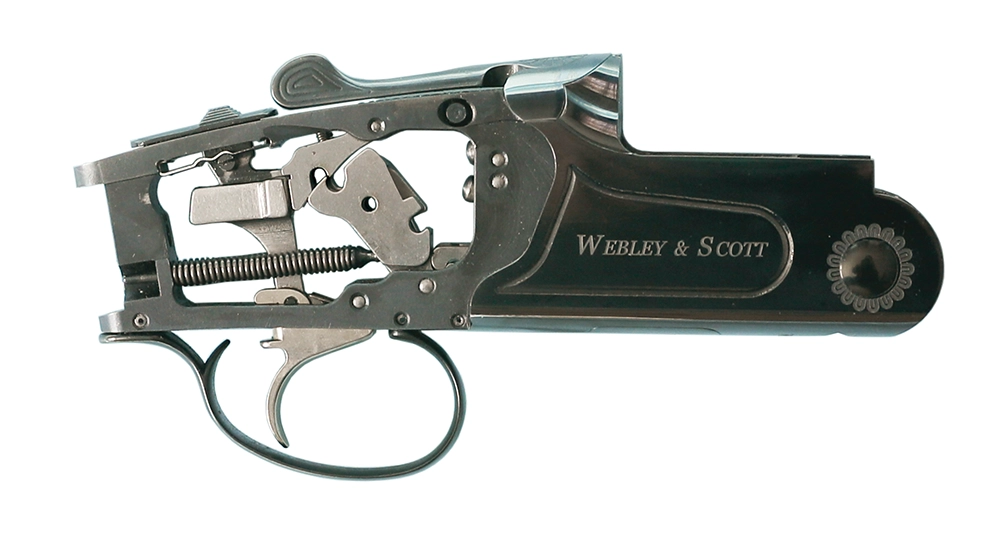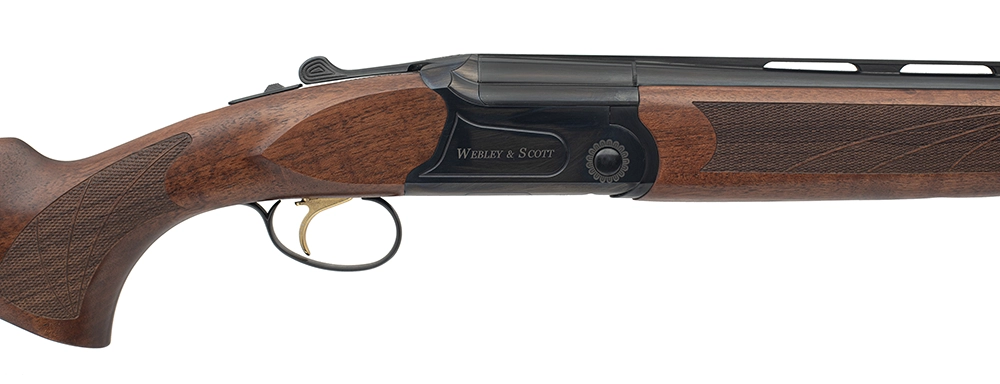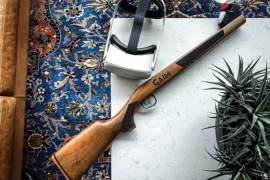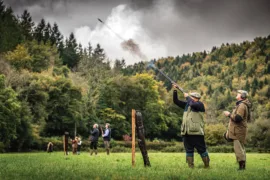From our July/August 2025 Issue
Recently I have reviewed guns associated with brands with a storied past: Frederick Beesley, Charles Daly and now Webley & Scott. Each has been unique in approximating its legacy. This time I am covering Webley & Scott’s 920BC. The 920BC is a 20-/28-gauge combo available with 26“, 28“, 30“ or 32“ barrels for $2,499. It is a gratifying and versatile shotgun worthy of one of the oldest names in the gun industry.
Webley & Scott, founded in Birmingham, England, in 1790, claims it has produced “some of the most famous firearms the world has ever seen.” Webley made esteemed revolvers and pistols, a well-regarded rifle action for the .470 Nitro Express, nifty air rifles and pistols, and classy shotguns for the old Army & Navy lineup. The 700 series side-by-sides introduced in the 1940s were sublime boxlocks. Provided they are in good shape, I recommend them to get folks into affordable English doubles. Earlier this century Webley & Scott shotgun manufacturing moved to Turkey with the advent of the 900, 950 and 1000 series of over/under target and field guns.
The 920BC is made in Turkey by Akdas Outdoors. Akdas was founded in 1948 as a small rifle-making operation but expanded into making side-by-side, over/under and inertia-operated shotguns. In 1987 Akdas established a “modern industrial scale” factory. In 2021 Akdas Outdoors was established with a commitment to “diligently working to blend the heritage of the past with modern technology” and introduce “foreign hunters and target shooters to the quality of Turkish made shotguns.” The 920BC achieves these goals.

On the gun we tested, the distinguishing feature between the two sets of 30” barrels was weight. The 20-gauge barrels weighed 3 pounds and the 28-gauge tubs 2 pounds 13 ounces. Otherwise they were equally well executed. They are deep drilled, chrome lined and steel safe. In lieu of traditional bluing, the barrels are black chromed, and the lustrous finish on both of our tube sets was exceptional. Patents for black chrome plating date back to 1952, and Rock Island Arsenal, in Illinois, applied the process to artillery parts and military equipment. My understanding is that Ithaca's SKB models from the 1970s were black chromed. The process was refined and modernized over time and today offers a hard, corrosion-resistant and durable finish. Several Turkish manufacturers maintain that it is æbetter than traditional bluing.” I suspect it is affordable and quicker. I can confirm that my two SKBs still look fantastic after lots of hard use.
The 920BC’s muzzles were crisp and had no gaps at the rib-end plugs. The ¼”-wide, machine-filed, ventilated top ribs were adorned with red fiber sights. (Personally, I would like to see such sights relegated to the dustbin of gunmaking history.) The top-rib jointures were outstanding; however, some wayward bits of solder peeked out along both sides of the mid-ribs. The barrel seams at the monoblock were practically invisible and what I would expect to see on far-more-expensive guns.
The monoblocks received desultory jewelling, but polished steel would be more attractive here. The machining for the lugs and bites was clean and precise. The trunnion cutouts had some roughness that did not impede fit or function. The machining for the ejector components was imprecise, and though the parts were secure, imperfections at the edges resulted in noticeable gaps and asymmetry in the geometry. None of this was detrimental to function. The 3” chambers transition to 1” forcing cones, and the barrels are overbored from nominal. The 20-gauge barrels measure .629” (nominal is .615”), and the 28-gauge barrels measure .551” (nominal is .545”).
The Cylinder, Improved Cylinder, Modified, Improved Modified and Full chokes that are supplied for each set. of barrels have wrench cutouts and are notched on the ends and labeled on the shafts to indicate constriction. All are steel safe through Modified. The Modified and Improved Cylinder chokes measured closer to Modified and Skeet, while the others were spot-on-nominal. All threaded with ease and sat flush to the muzzles. The plastic wrench was surprisingly functional.
The 20-gauge receiver is 1-1/3” wide and shares the same exceptional black chrome finish as the barrels. The sides of the receiver have milled borders that mimic bolsters and frame a prominently engraved “Webley & Scott.” The milling here was imprecise but mostly disguised by the black finish. Unadorned hinge-pin faces are bordered by simple, albeit asymmetrical, engraving. “Webley & Scott 920BC” and an interlocking “WS” are engraved on the bottom. The walls, face, knuckle and lug cutouts were well machined with no tooling marks, and white, steel, parallel cocking mechanisms fit snugly at the bottom of the well. Overall, the receiver had a unique contemporary shape and spirited forward lean that looked cool.
A Brescia-derivative lock-up features a broad locking bolt that emerges at the bottom of the action face and engages bites at the rear of the monoblock. Lugs at the bottom of the monoblock settle into cuts at the bottom of the action. Barrels pivot on replaceable pins. It all looks good, and the consensus for decades has been that it works!
The internals reflect the increasing level of quality from Turkish manufacturers. The forged white steel parts had keen edges and a precise fit. While the hammers and sears were hardly polished, they were clean and devoid of insulting machine marks. The selector block was coarse but not so egregiously as to impede function. Firing pins sat deep at the front of the action. Coil-spring assemblies ran along the bottom. The entire package is compact and well assembled.

The engraved blued toplever opened with a slight hitch, and the barrel selector and manual-safety switch left something to be desired. The switch, which looks like a diminutive Mayan temple, worked, as the barrels were properly selected and the gun remained “safe” or ready to fire as indicated, but the side-to-side and fore-and-aft movements were gritty and clunky. An automatic safety comes in the box and can be fitted to the gun—preferably by a competent gunsmith. The safety leaf spring rides over a slide pin and engages a screw that serves as a detent. Quality control to ensure the proper polishing and function of these parts would avoid this detraction from an otherwise fine action. Fortunately, the wide-blade single mechanical trigger proved redeeming. The pulls for both barrels had only the slightest take-up and zero creep and broke cleanly at 5 pounds.
According to Webley & Scott, the 920BC comes with “well figured grade 2.5 Turkish Walnut.” In the case of our gun, the wood had figure and looked nice—and for the price, the discernible contrast and smooth, uniform oil finish resulted in a comely little stock.
The stock and forends were graceful and svelte. The pistol grip, sculpted knob and agreeable reach and wrist were pleasant in the hand. The crisp laser-cut checkering has a unique shape and pattern, with stylized arcs. It is not traditional but looks sharp. The wood-to-metal fit rivaled tolerances on costlier shotguns. Unfortunately, there was no oil finish inside the head of the stock. The length of pull measured 14½” to the back of a well-fit rubber pad accented with a hard plastic heel. The grand little addition at the heel eliminates snags and promotes a graceful mount. The rest of the dimensions were: 1⅜” drop at comb, 2¼” drop at heel, neutral cast and 4° of pitch.
The trim forends were comfortable, with a hint of Schnabel noses. They shared the same stylized checkering pattern as the stock. It is a unique aesthetic that suggests forward motion. The Deeley latches and itrons had flawless inletting and made for effortless removal and staunch attachment. They were so nice that I was able to look past the lack of oil finish on the undersides of the wood.
Fully assembled, the gun weighed 7 pounds with the 28-gauge barrels and 7 pounds 3 ounces with the 20-gauge tubes. Three ounces is significant in terms of gun weight, but it was not so significant that the configurations felt entirely dissimilar. That said, the 28-gauge balanced right at the knuckle and had a suggestion of heaviness under the forehand. The gun came to the face easily and handled nimbly. The 20-gauge balanced in front of the knuckle and was noticeably heavier up front and a bit slower to the face.
At the patterning board, shooting 20-gauge Federal Top Gun 2¾” 7/8-oz No. 8s at 1,200 fps and 28-gauge Browning Sporting 2¾” ¾-oz No. 7½s at 1,300 fps through IC & M chokes, the gun patterned 50/50 with perfect convergence. Properly timed ejectors tossed empties three feet over my right arm.
Orvis Gunsmith Connor Carson and I took the 920BC to the 5 Stand, and the gun did not disappoint. Connor immediately exclaimed, “Very pleasant to shoot!” Recoil was very manageable in the 20-gauge and approached insignificant in the 28. We shot at chandelles, sharp crossers, straightaways and whatever weird report pairs we could configure. Both barrel sets pointed with ease. Swing and follow-through were smooth and even. We connected on just about everything with convincing breaks. The 28-gauge was more delightful to carry, but both of us were hard pressed to choose a favorite.
Afterward, I immediately emailed Webley & Scott’s Matt Nelson with my impressions: “Just had the chance to shoot. Wow! Nice gun.” The message was honest and straightforward—just like the gun. The 920BC is not some cobbled-together bi-gauge, but rather a well-thought-out, versatile and integrated package. The gun is not meant to be fancy but ot be an effective shooting tool. I confess to being a nitpicker and often find shortcomings that many people would not notice or disregard. In the case of the 920BC I acknowledged them and moved on, and the gun was so pleasant to look at and so much fun to shoot. The contours of the stock, with its unique checkering and effortless melding to the glossy receiver and barrels, yield an understated elegance. The gun is adaptable and compelling. Both sets of barrels work for clays, but I would opt for the 28s chasing quail and the 20s swinging on targets. Often shooters buy combos, and one set of barrels slumbers in the case. That would not be so here, as any wingshooter would want to use both as often as possible.
For more information, visit webleyscott.com.
Read our Newsletter
Stay connected to the best of wingshooting & fine guns with additional free content, special offers and promotions.





7lbs is way too heavy for a field gun that you’ll be carrying all day. I’ll take my Browning Superlight Feather any day of the week. Weighing 5lbs and 6oz, it’s a dream to carry and shoot.